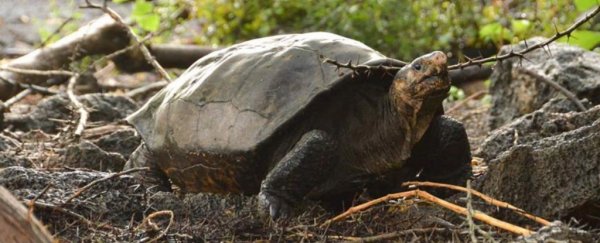When Charles Darwin famously visited the Galapagos Islands back in 1835, he discovered a volcanic archipelago that was home to 15 different species of giant tortoise.
Today, after killing off more than 100,000 of these strange creatures, we are down to about 10 species, many of which are critically endangered. One was missing for over a century.
The Fernandina giant tortoise (Chelonoidis phantasticus) was last seen on a voyage in 1906. Since then, no other example of this species has been found on the island of Fernandina, and some have even questioned whether they existed in the first place.
Classified as critically endangered and nearly given up for extinct, scientists have at last found another of these precious tortoises. This Sunday, a joint expedition between the Galapagos National Park and the Galapagos Conservancy managed to strike gold in a remote part of the island.
For the first time in more than 110 years, the team spotted an adult female Fernandina giant tortoise.
 (GNPD, W. Tapia)
(GNPD, W. Tapia)
This remarkable animal is thought to be more than 100 years old, which means she's pretty much the greatest hide-and-seek player there ever was.
Or maybe it's a skill that runs in the family. The investigators also noticed nearby tracks and scat, which makes them think there are more of these tortoises on the island. The possibilities for breeding have got conservationists excited.
"They will need more than one, but females may store sperm for a long time," Stuart Pimm, a conservation ecologist at Duke University, told the Associated Press. "There may be hope."
BREAKING NEWS! GC’s own @wacho_tapia just returned from Fernandina Island in #Galapagos, where they discovered a female #tortoise. Tortoises on Fernandina have been thought to be extinct for over 100 years, so this is a monumental finding! Photos © GNPD, W. Tapia pic.twitter.com/fhQpIzsHmM
— Galápagos Conservancy (@savegalapagos) February 20, 2019
Unlike many other species of giant tortoise, which have fallen prey to hunting and feral animals, the greatest threat to the Fernandina giant tortoise is not of human origin.
Believe it or not, it's actually the harsh habitat it lives in. The tortoise species is listed as critically endangered because experts think these creatures may have succumbed to "the frequent volcanic lava flows that nearly cover the island."
Congrats to the #ExtinctorAlive team and @ForrestGalante for finding a Fernandina tortoise presumed to be extinct since 1906! With her discovery, there's hope that more species are out there surviving against great odds. 🐢https://t.co/i824eLFEWb pic.twitter.com/2QkWyIkBIH
— Animal Planet (@AnimalPlanet) February 21, 2019
To protect these creatures from further harm, the investigators have taken the tortoise to a breeding centre for giant tortoises on the island of Santa Cruz.
